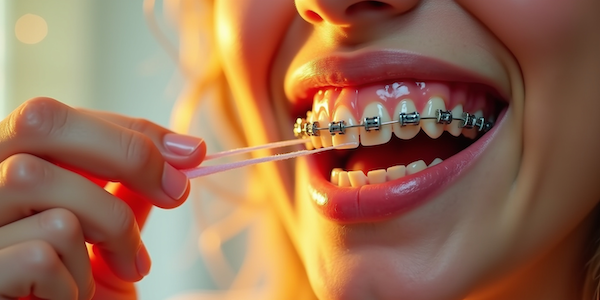Have you invested in braces and scheduled your appointments? Are you monitoring your progress? But there’s one crucial element that has to be given as much consideration as your teeth’s metal or ceramic brackets: flossing!
Indeed, flossing is essential to keeping your teeth healthy, especially if you wear braces. However, why is it so important? And with those wires and brackets in place, how can you floss efficiently? Don’t worry! This blog is here to answer all your questions!
It goes into detail about how to floss with braces and a variety of equipment to aid you in the process. If you are a parent, you will love the useful advice mentioned here for helping your children with braces.
Why Is It Important to Floss, Particularly if You Wear Braces?
Even in the best of circumstances, maintaining good oral health can be difficult. Still, braces present special challenges, such as plaque buildup. It is a sticky layer of germs that builds up on teeth. It can cause gum disease and cavities if ignored. Approximately 4 million Americans wear braces. Many of them may have plaque buildup issues.
Flossing helps get rid of food particles and plaque between teeth and around brackets that toothbrushes can’t get to. Effective flossing can ensure your braces treatment progresses smoothly without any unexpected detours.
How to Floss With Braces
Are you prepared to learn how to floss teeth with braces? To make this work easier to handle and more efficient, a variety of tools are accessible. Let’s get into depth about each option here.
-
Conventional Dental Floss
One of the most widely used oral hygiene products is traditional dental floss. It clears the space between teeth with a thin, flexible thread. Doesn’t it sound simple? It is!
How to Use Dental Floss With Braces
Check out the steps to use it effectively.
- Select the Proper Floss: Opt for waxed dental floss, as it glides more smoothly between teeth and around brackets.
- Cut a Length: Measure about 18 inches of floss and wrap the ends around your finger for better control.
- Insert Gently: Slide the floss between teeth and gently press it against the sides of the brackets.
- C-Shaped Motion: Scrub the tooth from top to bottom while curling the floss into a “C” shape. Make sure to floss every tooth on both sides.
- Rinse and Repeat: To avoid cross-contamination, use a fresh floss segment for every tooth.
-
Water Flosser
For people who struggle with traditional floss, a water flosser, also known as an oral irrigator, is a great substitute. It cleans in between teeth and around braces using a jet of pulsing water.
How to Use a Water Flosser With Braces
It is simple to use:-
- Pour warm water into the flosser’s water reservoir.
- Pick an orthodontic tip made especially for braces instead.
- Lean over the sink and aim the flosser’s tip at the gum line to position it.
- To begin flossing, turn on the device and glide it between teeth and down the gum line, making sure to reach every bracket.
- To remove any last bits of debris, rinse your mouth when you are done.
-
Threader Floss
For people wearing braces, floss threaders are useful because they make it easier to move floss around brackets.
How to Floss With Braces With Threader Floss
Follow this procedure to use the threader floss effectively:-
- Get the Threader Ready: Insert a piece of dental floss that has been waxed through the device’s loop.
- Threader Insertion: Carefully slide the threader beneath the braces’ wire.
- Pull the Floss: Gently press on both sides of the floss until it encircles the base of the tooth.
- Floss: To ensure complete cleaning, move the floss up and down in a “C” form.
- Continue Until Completed: Use a fresh threader for each tooth as you work through them.
-
Orthodontic Flosser
An orthodontic flosser is made especially for people wearing braces, much like a water flosser. It has a specific tip for the best possible cleaning of the area surrounding braces.
How to Use Orthodontic Flosser While Wearing Braces
Here’s a step-by-step guide on how to use an orthodontic flosser:-
- Attach your flosser to the orthodontic tip.
- As with a regular water flosser, fill the reservoir with warm water.
- Before beginning, set the pressure to a level that feels comfortable.
- To ensure efficient irrigation, aim at each tooth and proceed slowly around the brackets.
- Give it a last rinse.
-
Dental Tape
Because dental tape is wider than regular floss, it slides between teeth more easily without causing braces any harm.
How to Floss With Braces Using Dental Tape
This process is a bit different from other flossers:-
- Choose the Proper Dental Tape: For improved maneuverability, look for choices that have been waxed.
- Cut the Tape: For improved dexterity, use approximately 18 inches of tape.
- Place With Care: Use a C-shape to slide the tape up and down while softly threading it between your teeth.
- Cover Both Sides: Be careful to thoroughly clean both sides of the teeth.
- Replace as Necessary: Use a new piece of tape for each pair of teeth.
-
Interdental Brush
Compared to regular floss, interdental brushes are tiny brushes made specifically to clean in between teeth and around brackets.
How to Floss Your Teeth With Braces Using an Interdental Brush
It is a simple process, as explained below:-
- Look for an interdental brush that will not harm your braces and fits easily between your teeth.
- Place the brush between your teeth and insert it gently.
- To remove food particles and plaque, gently move the brush back and forth.
- Carefully cover the places surrounding your brackets.
- To get rid of any debris that brushing may have left behind, rinse your mouth.
How Can Parents Assist Children Who Wear Braces in Flossing?
It might be a little stressful to navigate your child’s braces experience, particularly when it comes to minding their dental hygiene. The following advice can assist your youngster in keeping up a consistent flossing schedule:
- Educate: Explain to your child the value of flossing and how it affects their oral health in general. Young children are frequently inspired by knowing the cause-and-effect link.
- Give a Demo: Show them how to utilize various flossing instruments by providing a demonstration. Sometimes, a visual example is more effective than just verbal instruction in helping children understand procedures.
- Make it Fun: To make the routine less boring, including timers or upbeat music.
- Offer Rewards: Small incentives can go a long way. Consider setting up a reward system for consistent flossing.
- Set Reminders: Remind your child to brush and floss every day by using a calendar or an app.
- Follow-up: Make sure they are sticking to their flossing schedule by checking in with them on a regular basis. A little responsibility goes a long way!
Flossing while wearing braces can seem intimidating, but with the correct equipment and methods, it becomes just another aspect of your dental care regimen. Making flossing a priority helps your orthodontic treatment succeed and improves your dental health.
Every tool mentioned in this blog has its unique advantages. Examine each option to see which one best suits your daily schedule.
So now that you are equipped with the knowledge of how to floss with braces, gear up, grab those flossing tools, and embrace this essential step to ensuring a bright, healthy smile when those braces finally come off!
FAQs
-
Can braces be worn while flossing?
Of course! It is both feasible and necessary to floss while wearing braces in order to maintain proper dental hygiene. It aids in clearing away plaque and food particles that may build up around the wires and brackets.
-
How frequently should you floss if you are wearing braces?
Ideally, you should floss at least once every day. Despite the additional difficulty of wearing braces, this daily regimen helps to maintain the health of your teeth and gums.
-
Which is the simplest way to floss while wearing braces?
The procedure can be considerably streamlined by using orthodontic floss picks or a floss threader. You can more easily move the floss between your teeth and around your braces with the aid of these gadgets.
-
Is it better to floss after brushing your teeth or before?
Ideally, flossing should be done prior to brushing. This way, you can efficiently clean in between your teeth first and then remove any dirt and plaque that may have come loose.
-
When is the right time to begin flossing?
You can begin flossing at any time! Including flossing in your dental care practice today will significantly improve your overall oral health, even if you haven’t done it previously.
-
When should you use floss?
Ideally, you should floss every day right after your final meal. This time enables you to remove any plaque and food particles that have accumulated and could cause tooth decay.
-
Why is it difficult to floss when wearing braces?
Because of the brackets and wires, flossing with braces can be challenging. Accessing all of the spaces between your teeth may become more difficult as a result of these barriers. But it becomes manageable with the correct tools and methods.
-
Is flossing more crucial for those wearing braces?
Yes, frequent flossing is significantly crucial for people wearing braces. Consistent flossing helps prevent cavities and gum disease since braces increase the surface area to which plaque can adhere.
-
Why is flossing painful?
It might be uncomfortable to floss, particularly if you have sensitive gums or are new to the activity. Be careful and make sure you are using the right technique. If you still feel pain and the discomfort continues, see your orthodontist.
-
Is it okay to floss before brushing?
It is quite acceptable to floss before cleaning your teeth. This approach is popular because it enables more efficient cleaning.
-
What occurs if you wear braces and don’t floss?
When wearing braces, forgetting to floss can result in plaque buildup, which can lead to gum disease and cavities. Additionally, because plaque is frequently overlooked by brushing alone, you can see discoloration around your braces after they are taken out.

Dr. Brian Thurman has spent his entire life enjoying all the beauty that California has to offer. A Fresno native, he still escapes to the ocean or the mountains whenever his busy schedule allows. Driven by his love for natural beauty, Dr. Thurman enjoys creating beautiful smiles and healthy bites that last a lifetime. He is proud to be the only Ivy League trained Orthodontist in the Fresno/Clovis area.

